Looking for a substitute for cocoa powder for a recipe or treat? We’re covering 12 practical substitution options for cocoa powder! You’re sure to find one that’s just right.
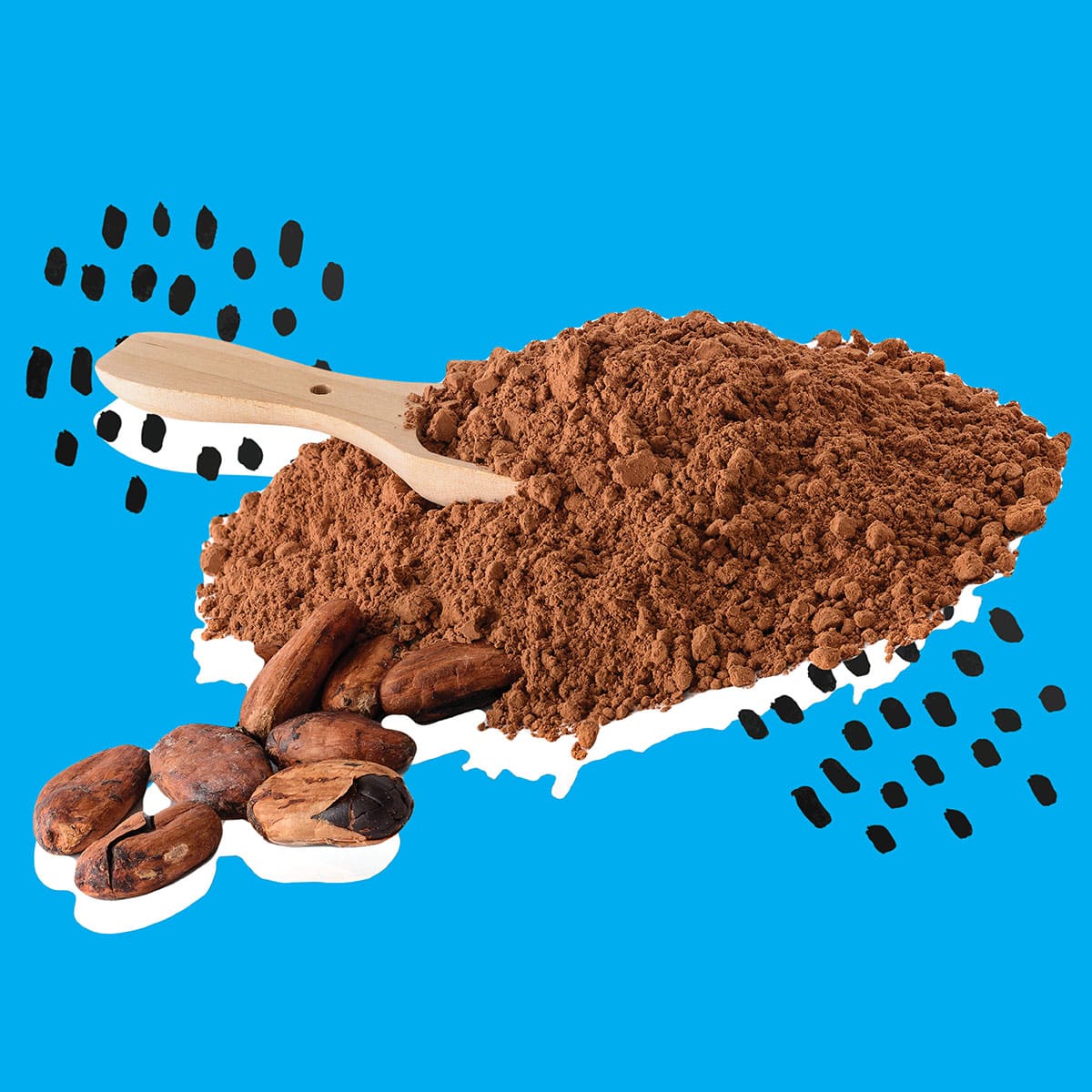
Cocoa Trivia!
How long ago were cacao beans first used to make chocolate?Answer is at the bottom of this post!
What is Cocoa?
Cacao trees produce seed pods called cacao beans that give the world chocolate. Cocoa or chocolate is the result of fermented and roasted cacao beans. These seeds are native to the Americas and were once used as currency (that’s my kind of society).
Nowadays, over 70% of the world’s cacao is grown in West Africa and is then shipped off to be made into chocolate around the world.
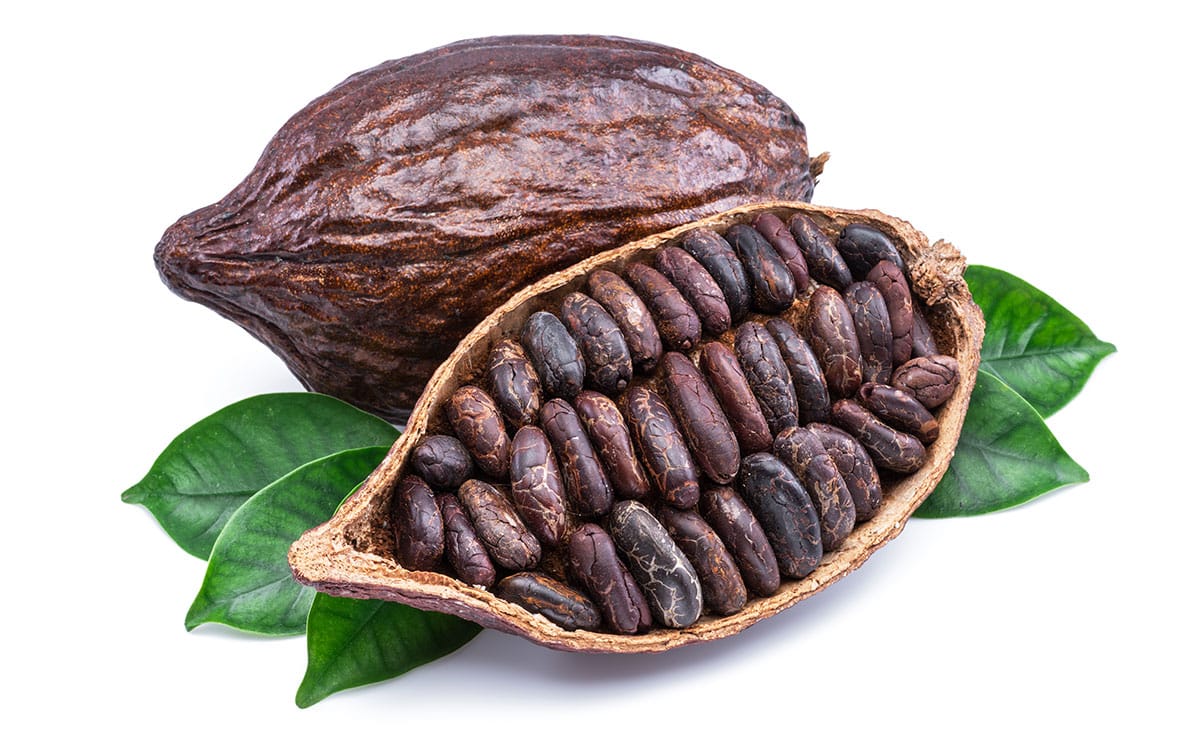
Cacao, Cocoa and Chocolate Forms
Chocolate and cocoa powder are not the same! So to start, we think it’s helpful to differentiate between all the different products that come from the cocoa bean.
- Cacao nibs and powder: This is the raw, unroasted cacao seed. It’s significantly more bitter than roasted cocoa but retains more of its nutrients.
- Cocoa nibs and powder: Cocoa is the roasted equivalent of cacao. It is less bitter and closer to what you may be used to eating and cooking with.
- Dutched Cocoa Powder: This is alkalized cocoa powder, meaning it has a more neutral pH and is less bitter than regular cocoa powder. It dissolves easily so it’s great for making hot cocoa!
- Dark Chocolate: Cocoa + Cocoa butter + Sugar
- Milk Chocolate: Cocoa + Cocoa butter + Sugar + Milk
- White Chocolate: Cocoa butter + Sugar + Milk
How is Cocoa Powder Made?
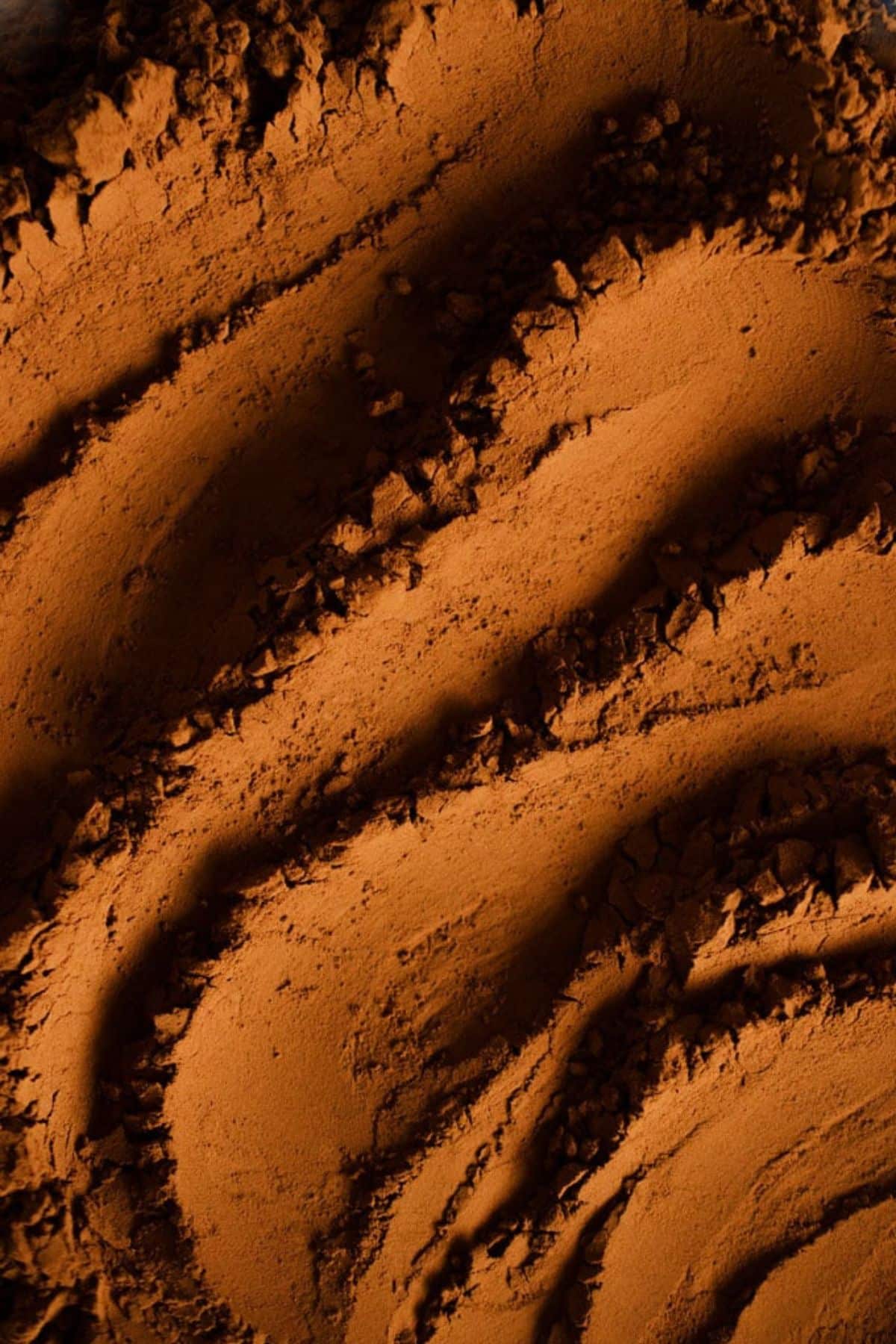
The process of making cocoa powder involves several steps:
- Harvesting: Cocoa beans are harvested from the cacao tree’s pods.
- Fermentation: The beans are removed from the pods and placed in shallow containers to ferment for a few days. This fermentation process helps develop the bean’s flavor.
- Drying: After fermentation, the beans are spread out in the sun or in drying rooms to reduce their moisture content.
- Roasting: The dried beans are roasted to bring out their rich chocolate flavor. The specific roasting temperature and duration can vary, and it can affect the flavor of the cocoa.
- Cracking and Winnowing: The roasted beans are cracked to remove the outer shells, leaving behind the cocoa nibs. The nibs are then winnowed to separate them from the shell fragments.
- Grinding: The cocoa nibs are ground into a paste called chocolate liquor, which doesn’t contain alcohol despite the name. This paste can be further processed to separate cocoa solids from cocoa butter.
- Pressing: In some cases, the chocolate liquor is pressed to separate cocoa solids (cocoa powder) from cocoa butter. The remaining solids are then finely ground into cocoa powder.
- Dutch Process (optional): Some cocoa powder is treated with an alkaline solution in a process known as Dutch processing. This results in “Dutch-processed” or “alkalized” cocoa powder, which has a milder flavor and darker color.
This process gives us cocoa powder, which is naturally quite bitter. This is why it is generally combined in recipes with sugar or some other sweetener. It is also why most recipes will also call for baking soda. The alkaline in baking powder helps balance the natural acidity of cocoa powder.
Social Issues Within the Cocoa Industry
The Ivory Coast is the world’s leading producer of cacao beans followed by Ghana. Together they produce about 60% of the world’s cocoa.
The 400-pound gorilla in the room here is how cacao beans are harvested. The US Department of Labor estimates that 1.56 million children work in these two countries in the labor-intensive, machete-wielding, business of harvesting the beans. Many of these children are working innocently enough on the family farm.
Another scenario, described to me on my travels in Ghana, is a family with only a small plot of land that has more children than they need to work their land and not enough money to support them all. So, many kids are “hired out” to larger plantations. The conditions on these plantations are said to “vary”. We aren’t passing judgment on chocolate here, but this is something to keep in mind.
For some people, it’s a significant enough issue to limit their use of cocoa-based products. If this is why you are looking for a substitute for cocoa powder, good for you. If you are just looking for a new taste or maybe healthier options, that’s great too.
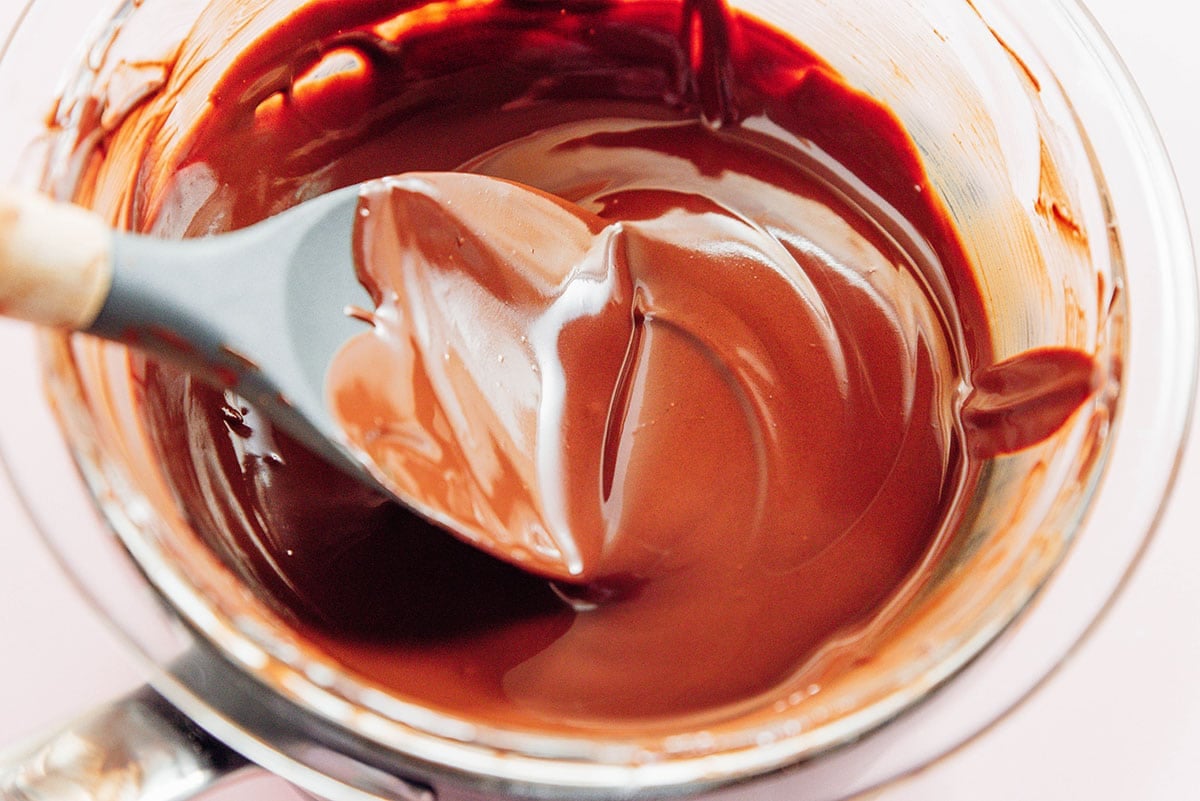
Substitutes For Cocoa Powder
Now that we’ve gone over all the details of cocoa powder, let’s get into the substitutes! Our recommendations will provide tasty options for when you don’t have cocoa powder on hand or need a more conscious option.
- Cacao Powder
- Carob Powder
- Black Cocoa Powder (A Dutch Processed Cocoa Powder)
- Chocolate Chips or Chunks
- Malt Powder
- Espresso Powder
- Chocolate Syrup
- Dark Chocolate
- Unsweetened Baking Chocolate
- Hot Chocolate Mix
- Chocolate Protein Powder
- Nutella
Cacao Powder
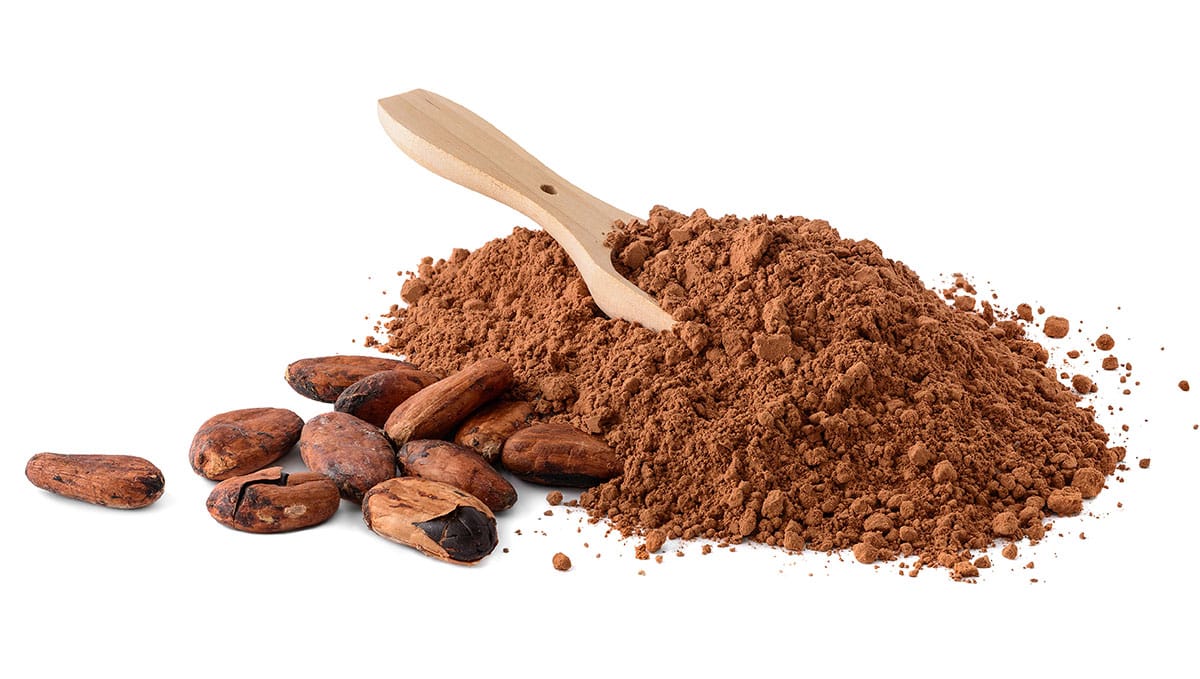
Cacao powder is a product made from crushed and processed cacao beans, the same beans from which cocoa powder and chocolate are derived. We think it is often the best cocoa powder substitute. The key difference between cacao powder and cocoa powder lies in their processing methods.
Processing Method
Cacao powder is made by cold-pressing unroasted cacao beans. This minimal processing method retains more of the natural cacao flavors and nutrients, such as antioxidants and minerals, than cocoa powder.
Nutritional Differences
Cacao powder is often considered a healthier option because it retains more antioxidants and beneficial compounds due to the minimal processing. It’s a better source of minerals like magnesium, iron, and potassium than cocoa powder.
Flavor Differences
Cacao powder generally has a more intense and bitter chocolate flavor compared to cocoa powder. Cocoa powder tends to be milder and less bitter. Using this substitute will result in a less sweet end product, but that’s a matter of taste preference.
How to Substitute
You should typically substitute cacao powder for cocoa powder in a slightly LESS than 1:1 ratio. If a recipe calls for 1 tablespoon of cocoa powder, try ¾ of a tablespoon of cacao powder instead and adjust based on your taste preferences. Because cacao powder has a more intense flavor, it will impart a stronger chocolate taste to your creations.
If your recipe relies on the leavening properties of cocoa powder (e.g., in baking), be aware that cacao powder may react differently due to its acidity. You may need to adjust other ingredients like baking powder or baking soda accordingly. Cacao powder also tends to clump more than cocoa powder, so you might need to sift it before use.
Best Uses for Replacing Cocoa with Cacao Powder
Cacao powder can be used in a wide range of recipes, such as smoothies, hot chocolate, brownies, cookies, cakes, and even savory dishes like mole sauce. Experiment with cacao powder in your favorite chocolate recipes, and adjust the quantity to suit your taste.
Carob Powder
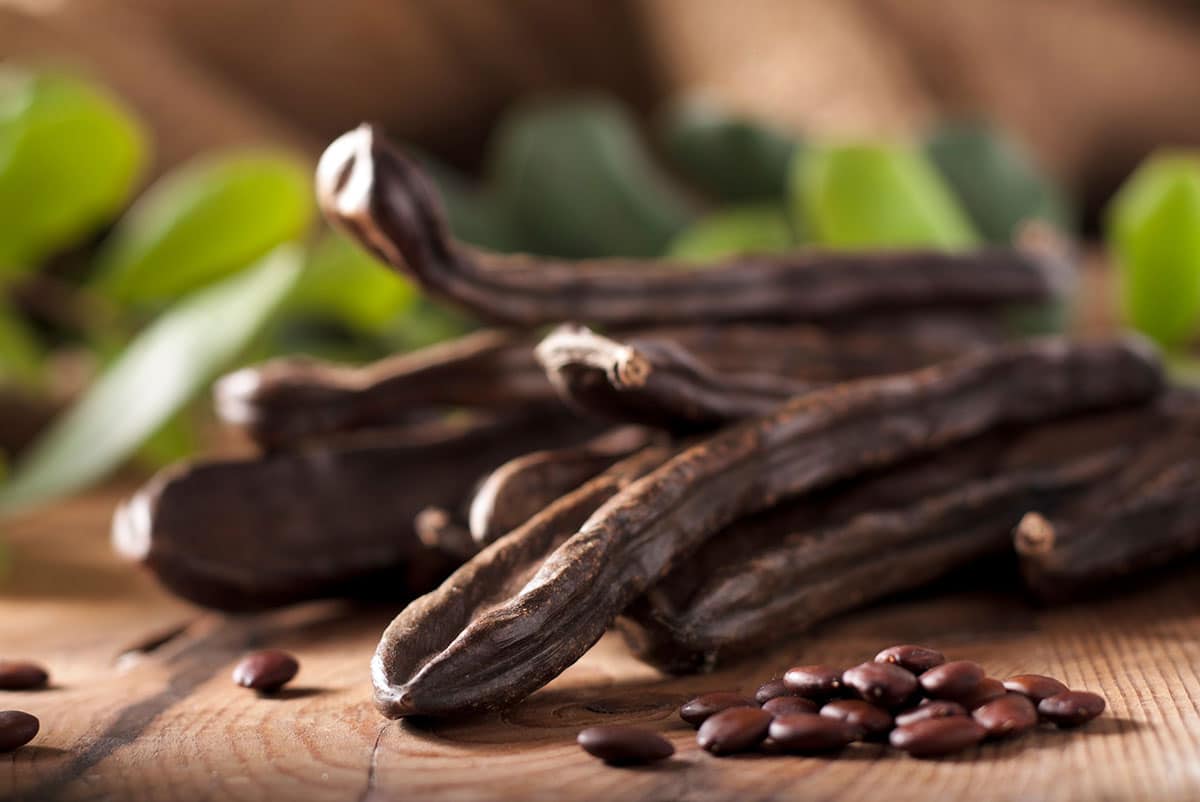
Carob powder is an ingredient made from dried and roasted carob pods, which come from the carob tree. Carob has been used for centuries as a natural sweetener and chocolate substitute due to its naturally sweet taste and cocoa-like appearance.
Flavor and Appearance Differences
Carob powder has a mild, naturally sweet flavor that resembles chocolate but is less bitter than cocoa powder. It also has a similar brown color, making it visually similar to cocoa. It generally makes a pretty good cocoa powder replacement.
Nutritional Differences
Carob is naturally caffeine-free, unlike cocoa, which contains theobromine, a stimulant that some people are sensitive to. Additionally, carob is often considered to be easier on the digestive system, making it a suitable option for those with sensitivities or dietary restrictions.
Carob is a good source of dietary fiber and contains vitamins and minerals, including calcium and potassium. It’s also lower in fat compared to cocoa powder.
How to Substitute Carob Powder for Cocoa Powder
To substitute carob powder for cocoa powder in your recipes, you can use a 1:1 ratio as a general guideline. However, keep in mind the following tips:
- Taste: Carob is naturally sweeter than cocoa, so you may want to reduce the sugar in your recipe slightly when using carob powder to avoid making your dish overly sweet.
- Texture: Carob powder can be slightly thicker and denser than cocoa powder. You may need to adjust the liquids in your recipe to achieve the desired consistency. Start with a slightly smaller amount of carob powder, and gradually add more if needed.
- Flavor: While carob has a chocolate-like flavor, it’s not an exact match for cocoa. The flavor may be milder and less intense. This can be a benefit in recipes where you want a less intense chocolate flavor.
Best Uses for Replacing Cocoa with Carob Powder
- Baking: Use carob powder in place of cocoa powder in recipes for cookies, brownies, cakes, and muffins.
- Hot Chocolate: Make a carob-based hot chocolate by mixing carob powder with hot milk or a milk alternative, sweetening to taste.
- Smoothies: Add carob powder to your smoothies for a chocolate-flavored boost.
- Dessert Sauces: Use carob powder to make chocolate-flavored sauces for drizzling over ice cream or fruit.
- Energy Bars: Incorporate carob powder into homemade energy bars for a chocolatey flavor.
Keep in mind that carob and cocoa have distinct flavors, so the substitution may not be suitable for every recipe. It’s a good idea to experiment and adjust the ratio to your taste preferences. Additionally, carob powder is less common than cocoa powder, so you may need to purchase it from specialty stores or online retailers.
Black Cocoa Powder (A Dutch Processed Cocoa Powder)
Black cocoa powder is an unsweetened type of cocoa powder that is distinctively dark and rich in flavor. It’s often used in baking to achieve a deep, intense chocolate color and flavor. The black color is a result of a highly alkalized cocoa powder, which means it has been treated with an alkaline substance to reduce its acidity.
This process, known as Dutch processing, not only darkens the cocoa but also gives it a smoother, less bitter taste compared to natural cocoa powder. This is a great substitute for regular cocoa powder.
Nutritional Differences
Black cocoa powder is similar to regular cocoa powder. It’s rich in antioxidants and contains some essential minerals like iron and magnesium. However, the alkalization process may slightly reduce the overall antioxidant content compared to natural cocoa powder. Additionally, black cocoa powder is lower in fat than regular cocoa powder.
Flavor Differences
The primary difference between black cocoa powder and regular cocoa powder is in its flavor. Black cocoa powder has a more intense, almost bittersweet chocolate flavor with a deep, robust taste. It lacks the fruity and acidic notes found in standard cocoa powder. This makes it an excellent choice for recipes where you want a strong, dark chocolate flavor, like in black forest cake or dark chocolate cookies.
How to Substitute Black Cocoa Powder for Cocoa Powder
When substituting black cocoa powder for regular cocoa powder in recipes it’s important to consider its strong flavor and dark color. To achieve a similar level of chocolate intensity, you can replace a portion of the regular cocoa powder with black cocoa powder.
A common guideline is to replace about 25-50% of the cocoa powder with black cocoa powder. Keep in mind that using black cocoa powder exclusively may result in an overly intense chocolate flavor and a very dark appearance, which may not be suitable for all recipes.
We recommend that for each ½ cup of black cocoa powder used vs normal cocoa powder, you add an additional 1 tsp of baking powder to make up for the lack of acidity. You may need to add a touch more butter or oil due to black cocoa’ lower fat content.
Best Uses for Replacing Cocoa with Black Cocoa Powder
Black cocoa powder is ideal for recipes where you want a deep, dark chocolate flavor and a striking black or dark brown color. Some of the best uses include:
Oreo-Style Cookies: Use black cocoa powder in your cookie dough to replicate the iconic dark color and intense chocolate taste of Oreo cookies.evil
Devil’s Food Cake: Replace part of the cocoa powder in your devil’s food cake recipe with black cocoa powder for an even richer chocolate flavor and a darker cake.
Brownies: Incorporate black cocoa powder into your brownie batter to create fudgy, intensely chocolatey brownies.
Chocolate Frosting: Add black cocoa powder to your frosting for a dramatic black frosting suitable for Halloween or 40th birthday cakes.
Dark Chocolate Ice Cream: Enhance the chocolate flavor of your homemade ice cream by using black cocoa powder in the base.
In summary, black cocoa powder is a powerful ingredient, and while it can be used as a substitute for regular cocoa powder, it’s essential to adjust the quantity to maintain the desired flavor and color in your baked goods or desserts. Experimenting with this unique cocoa powder may just lead to some great new chocolate creations in your kitchen.
Chocolate Chips or Chunks
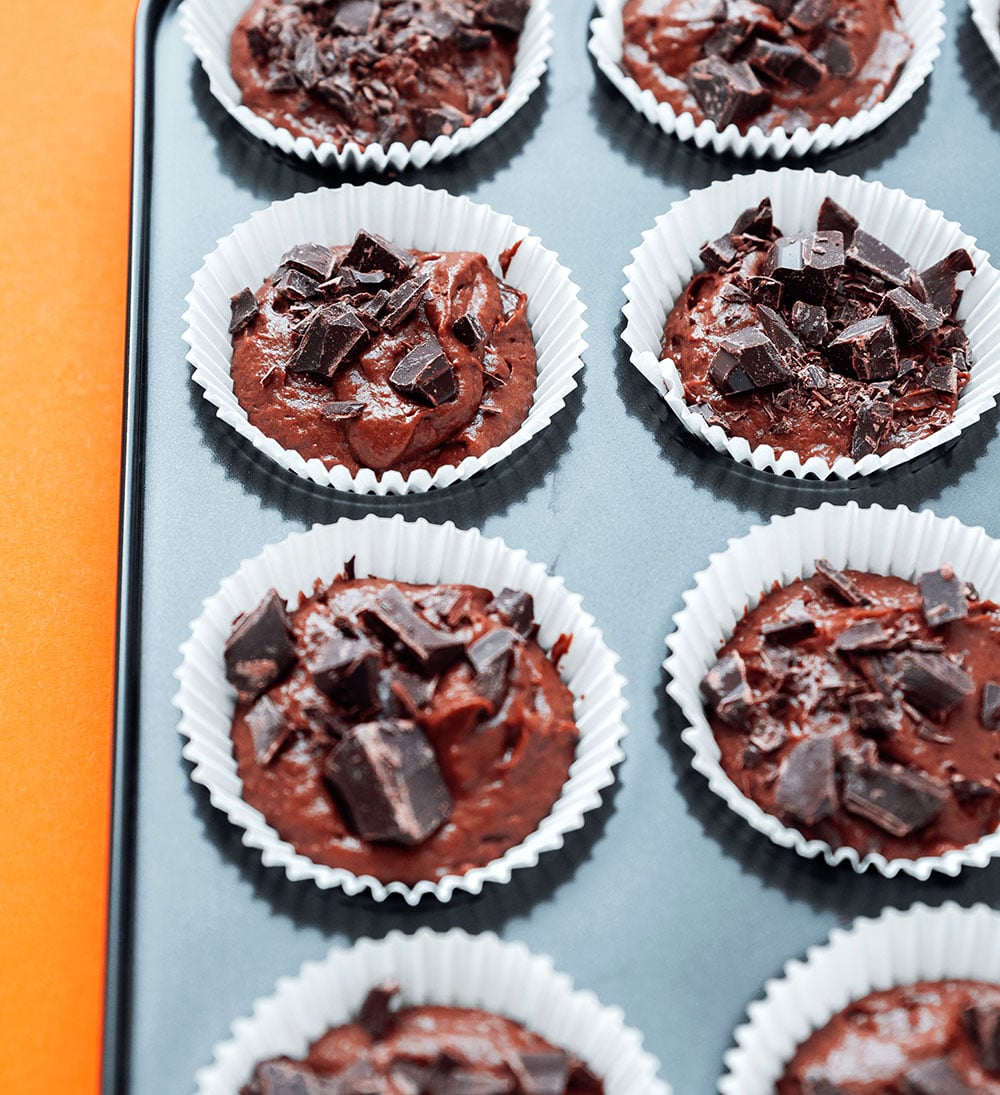
Chocolate chips or chunks are small, solid pieces of chocolate typically used in baking and confectionery. They come in various forms, including semisweet, bittersweet, milk, and white chocolate.
Chocolate chips are commonly found in recipes for cookies, brownies, cakes, and other desserts. They are specifically designed to hold their shape when baked, making them a popular choice for adding pockets of chocolatey goodness to baked goods.
Nutritional Differences
Cocoa powder is primarily composed of cocoa solids with minimal fat content, making it relatively low in calories. It’s a good source of antioxidants and has less sugar than chocolate chips or chunks. On the other hand, chocolate chips or chunks contain more fat, sugar, cocoa solids, and cocoa butter. This means that substituting cocoa powder with chocolate chips or chunks can result in a more calorie-dense final product.
Flavor Differences
Cocoa powder offers a deep, intense cocoa flavor that is less sweet and more bitter compared to chocolate chips or chunks. Chocolate chips or chunks, due to their sugar content and additional cocoa butter, contribute a sweeter, creamier, and more indulgent chocolate flavor to recipes.
When substituting, be prepared for a flavor shift toward sweetness and richness. The flavor difference between cocoa powder and chocolate chips or chunks can be substantial, so we advise going with unsweetened or semi-sweet chips.
How to Substitute Chocolate Chips or Chunks For Cocoa Powder
Substituting chocolate chips or chunks for cocoa powder requires adjustments to the overall recipe. To do this, follow these general guidelines:
- Reduce Sugar: Since chocolate chips or chunks contain sugar, reduce the amount of sugar in your recipe to account for the added sweetness. Start by reducing the sugar by about 1/4 to 1/3 of the cocoa powder’s weight. This may depend on the chips you bought. Unsweetened or semi-sweet chips may require no adjustment to sugar use.
- Adjust Fat: Chocolate chips or chunks contain cocoa butter, so you may need to reduce the amount of fat (butter or oil) in your recipe to prevent it from becoming too greasy. Start by reducing the fat by a small amount, around 1-2 tablespoons reduction per cup of cocoa powder substituted. Our best advice here is to add the chocolate chips first and then other ingredients, so you can adjust to taste.
- Melt and Incorporate: Melt the chocolate chips or chunks and incorporate them into the recipe as you would cocoa powder. This can be done by mixing them into a liquid component of the recipe, such as melted butter or milk.
- Experiment: The substitution ratio can vary depending on your taste preferences. It may take some trial and error to achieve the desired flavor and texture in your recipe.
Best Uses for Replacing Cocoa with Chocolate Chips or Chunks
- Chocolate Brownies: Chocolate chips or chunks can be an excellent replacement for cocoa powder in brownie recipes, providing a fudgier and richer texture. If you want to make brownies without cocoa powder, this is a good option.
- Chocolate Chip Cookies: Chocolate chip cookie recipes can benefit from using both cocoa powder and chocolate chips or chunks. The combination offers a balance of cocoa flavor and melty chocolate pockets.
- Molten Chocolate Cakes: When making molten lava cakes, substituting cocoa powder with melted or whole chocolate chips or chunks creates a gooey, chocolatey center that oozes when you cut into the cake.
- Hot Chocolate: Chips probably aren’t the best substitute for cocoa powder in hot chocolate, but you can melt chocolate chips or chunks into warm milk instead of using cocoa powder. This results in a creamy variant of the winter favorite.
In summary, while substituting cocoa powder with chocolate chips or chunks can add sweetness and richness to your recipes, it requires adjustments to sugar and fat content. The best uses for this substitution include brownies, cookies, molten chocolate cakes, and hot chocolate, where the enhanced chocolate flavor and texture can be appreciated.
Malt Powder
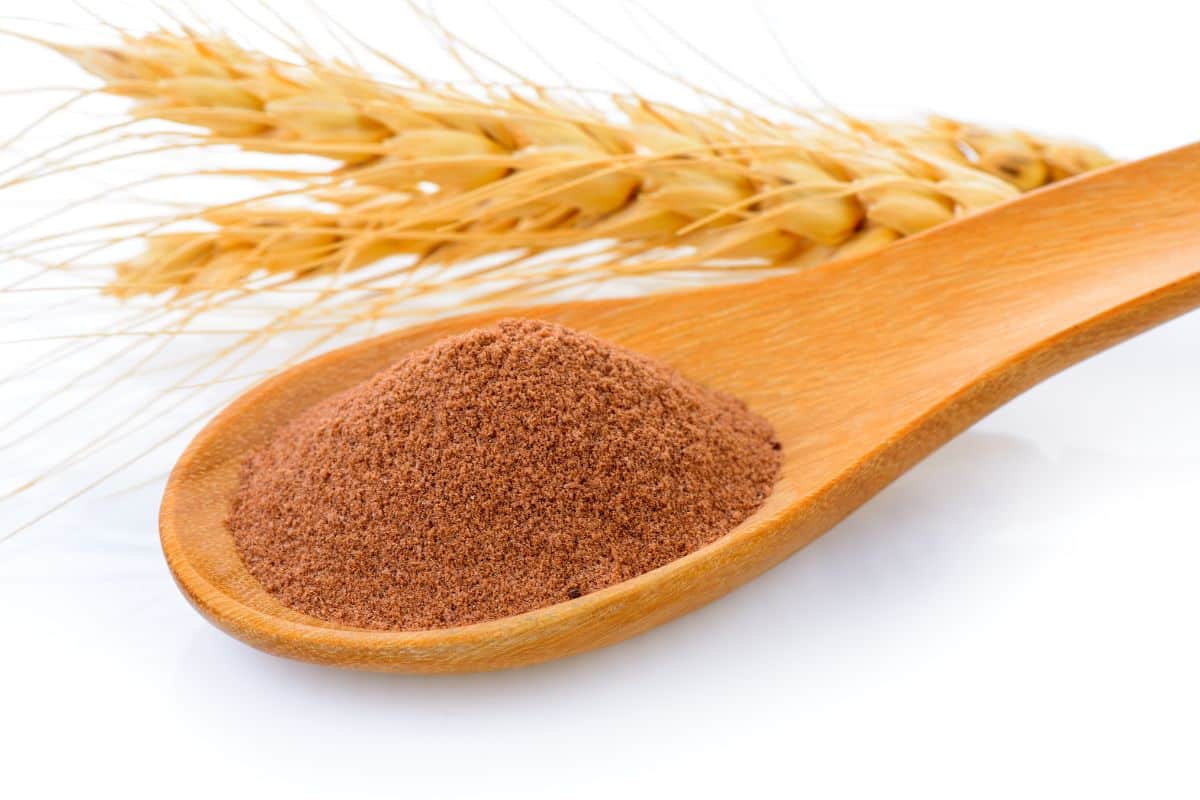
Malt powder is often used in baking and cooking to impart a distinct malted flavor and sweetness to various dishes. It’s typically made from malted barley, although other grains like wheat or rice may also be used. Malt powder is commonly used in brewing beer and making malted milkshakes, but its applications in the kitchen go well beyond that.
Nutritional Differences
Cocoa powder is often considered a healthier choice due to its higher concentration of antioxidants and lower sugar content. It’s also a source of dietary fiber. On the other hand, malt powder tends to be sweeter and higher in sugar, which can make it less suitable for those seeking a low-sugar or low-carb option. Conversely, malt powder may contain some vitamins and minerals from the grains used in its production, but it’s not as rich in antioxidants as cocoa powder.
Flavor Differences
The most noticeable difference between cocoa powder and malt powder is the flavor. Cocoa powder has a rich, deep chocolate flavor with varying degrees of bitterness depending on whether it’s natural or Dutch-processed.
In contrast, malt powder imparts a sweet, toasty, and malted flavor with a hint of caramel. This flavor can add a unique and delightful twist to your recipes. When substituting malt powder for cocoa powder, be prepared for the change in flavor, which can work exceptionally well in certain dishes, especially those that benefit from a sweet and malty undertone.
How to Substitute Malt Powder For Cocoa Powder
Start with a planning figure of 1-2 parts malt powder to replace 1 part cocoa powder in a recipe. We aren’t being very precise as this is something best done to taste.
- Reduce Sugar: Since malt powder is sweeter than cocoa powder, reduce the amount of sugar in your recipe slightly. Start by reducing sugar by about 25% and adjust to taste.
- Adjust Liquid: Malt powder can be more absorbent than cocoa powder, so you may need to add a bit more liquid to your recipe. This could be milk, water, or another liquid component already in the recipe.
- Experiment: Substituting malt powder for cocoa powder is a matter of personal taste. Experiment with different ratios until you achieve the flavor and texture you desire in your dish. Keep in mind that malt powder works best in recipes where the malty flavor complements the other ingredients.
Best Uses for Replacing Cocoa with Malt Powder
- Malt powder can be a fantastic replacement for cocoa powder in various recipes, particularly those that can benefit from its sweet and malted flavor profile. Here are some best uses for substituting cocoa with malt powder:
- Malted Milkshakes: Turn any milkshake recipe into a malted milkshake. Blend it with ice cream, milk, and other flavorings for a delicious and nostalgic treat.
- Malted Baked Goods: Incorporate malt powder into cookies, brownies, cakes, and muffins for a unique twist on traditional chocolate recipes.
- Malt-Flavored Frosting: Add malt powder to your frosting recipe for a sweet and malty frosting that pairs well with chocolate or vanilla cakes.
- Malted Hot Chocolate: Create a comforting malted hot chocolate by mixing malt powder with hot milk and a bit of cocoa powder for added depth.
- Malt-Flavored Ice Cream: Make homemade malt-flavored ice cream to enjoy the distinctive taste of malt in frozen form.
In summary, malt powder offers a delightful alternative to cocoa powder with its sweet, malty flavor. It’s important to adjust other recipe components like sugar and liquid when substituting malt powder, but when used in the right amount and recipe, it can enhance the flavor and bring a unique and nostalgic twist to your culinary creations.
Espresso Powder
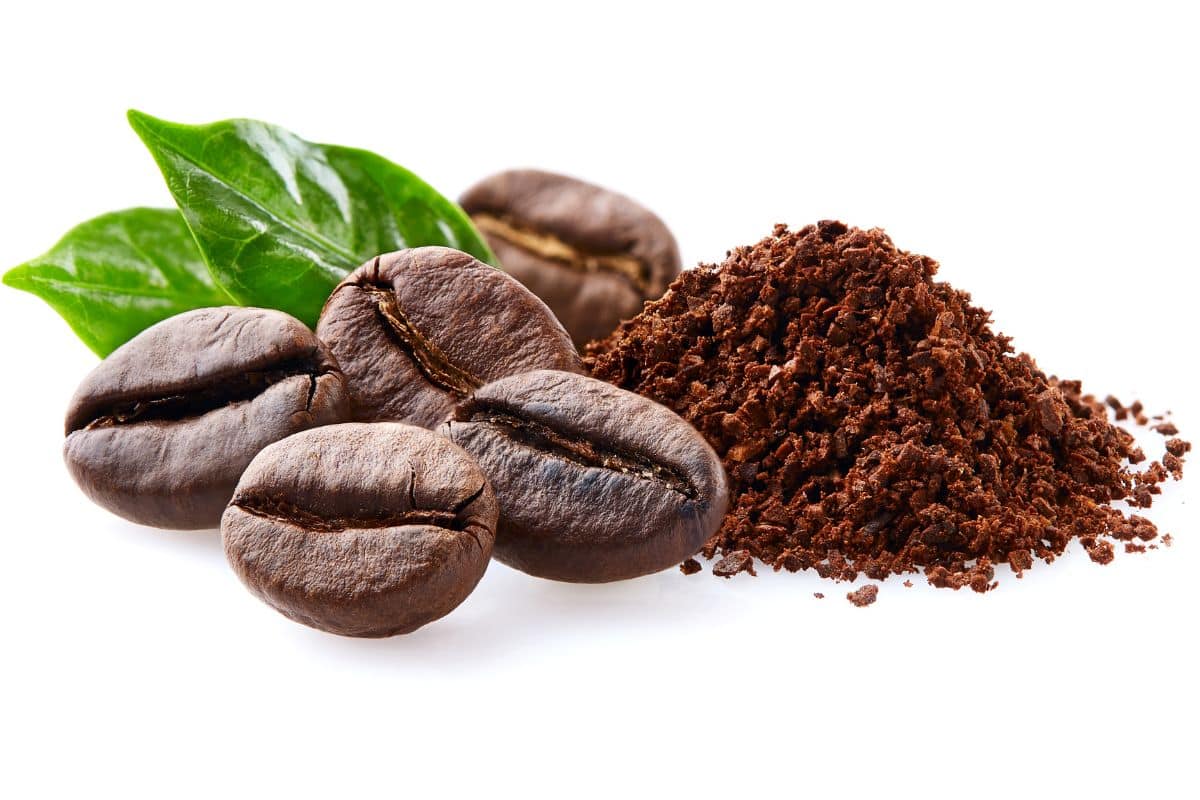
Espresso powder is a concentrated coffee product made by grinding brewed espresso beans into a fine powder. It is known for its intense coffee flavor and aroma. While it may share some similarities with instant coffee, it tends to have a more robust and complex taste, making it a favorite among coffee enthusiasts and bakers alike.
Nutritional Differences
Espresso powder is low in calories, fat-free, and a good source of antioxidants. On the other hand, cocoa powder is also low in calories but contains more fat and fiber. Cocoa powder offers some health benefits due to its antioxidants, such as flavonoids, which have been associated with heart health. Espresso powder, while lower in fat, can provide a caffeine boost, but it doesn’t contain the same antioxidants as cocoa.
Flavor Differences
The primary distinction between espresso powder and cocoa powder lies in their flavors. Espresso powder offers a deep, intense coffee taste with subtle bitterness and a touch of sweetness. It can enhance chocolate flavors and create a mocha-like richness.
In contrast, cocoa powder has a pronounced chocolate flavor with mild bitterness and a hint of natural sweetness. While they both contribute to a recipe’s depth, the flavor of espresso powder is more coffee-centric, while cocoa powder emphasizes chocolate notes.
How to Substitute Espresso Powder For Cocoa Powder
Substituting espresso powder for cocoa powder in recipes can be a nice twist, especially if you enjoy coffee-flavored desserts or want to enhance the chocolate flavor. To do so, follow these guidelines:
- Adjust the Quantity: Start by using about half the amount of espresso powder as the cocoa powder called for in the recipe. Espresso powder is more potent, so a little goes a long way. Consider just replacing part of the cocoa powder.
- Consider Liquid Content: Keep in mind that espresso powder absorbs less liquid than cocoa powder, so you might need to adjust the recipe’s liquid content slightly. Add a bit more liquid, such as milk or water, if the batter seems too dry.
- Balance Sweetness: Espresso powder can be slightly bitter, so you may want to increase the sweetener in your recipe, like sugar or honey, to achieve the desired sweetness level.
- Taste and Adjust: Taste the batter or dough as you go along to ensure the coffee flavor is not overpowering. Adjust the espresso powder or sweeteners as needed to achieve the desired balance.
Best Uses for Replacing Cocoa with Espresso Powder
- Mocha Flavored Desserts: Espresso powder is a fantastic addition to mocha-flavored desserts like brownies, cakes, or cookies. It pairs nicely with chocolate, creating a rich and indulgent combination.
- Tiramisu: Espresso powder is a key ingredient in tiramisu, a classic Italian dessert. It infuses the dessert’s layers with a deep coffee flavor that complements the creamy mascarpone. This isn’t really a substitute! It is just our favorite use of espresso powder.
- Coffee-Flavored Frostings: Espresso powder can be incorporated into buttercream or cream cheese frostings to create a coffee-flavored topping for cupcakes or cakes. Again, perhaps only use this as a partial cocoa replacement.
- Coffee Ice Cream: Use espresso powder to make homemade coffee-flavored ice cream or gelato. It provides a bold coffee kick in every scoop. Use it in this faux ice cream made from frozen bananas.
In summary, espresso powder can be used to replace cocoa powder in select recipes, offering a distinct coffee flavor and enhancing the richness of chocolate. You may not want to substitute all the Cocoa in a recipe with espresso powder or consider another replacement option along with the espresso powder.
Chocolate Syrup
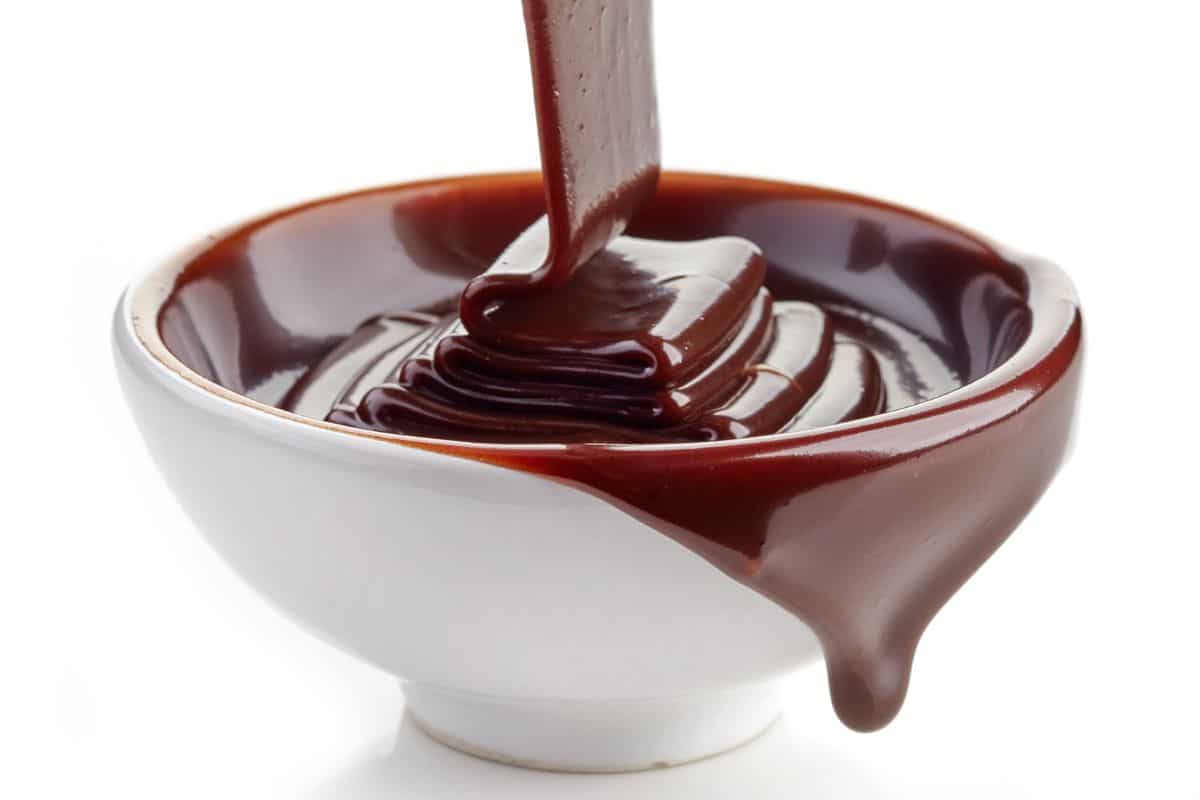
Chocolate syrup is a sweet, liquid chocolate-flavored condiment commonly used in desserts and beverages. It’s made from ingredients such as cocoa powder, sugar, water, and sometimes corn syrup or other sweeteners.
Chocolate syrup is known for its thick, glossy texture and rich chocolate taste. It is a versatile ingredient that can be drizzled over ice cream, mixed into milk for chocolate milk, used in baking, or even stirred into coffee for a mocha flavor.
Nutritional Differences
Cocoa powder is typically lower in calories and sugar compared to chocolate syrup, though you can buy zero-sugar and lite chocolate syrups. Cocoa powder is also a good source of antioxidants and has less fat. On the other hand, chocolate syrup is higher in sugar and often contains added ingredients like corn syrup, which can increase its calorie content.
Flavor Differences
One of the most significant differences between cocoa powder and chocolate syrup is the flavor. Cocoa powder has a more intense, pure chocolate flavor with a slight bitterness, which can be balanced with sugar in recipes. Chocolate syrup, on the other hand, is sweet and has a smoother, milder chocolate taste. When substituting chocolate syrup for cocoa powder, be prepared for a sweeter and less intense chocolate flavor in your final dish. Adjust the amount of sugar in your recipe as needed to achieve the desired sweetness.
How to Substitute Chocolate Syrup for Cocoa Powder
Substituting chocolate syrup for cocoa powder in a recipe is relatively straightforward. Here’s a general guideline:
- Measurement: Start with a 2:1 replacement (2 parts syrup by weight to replace 1 part cocoa powder), and adjust this ratio based on your taste preferences and the sweetness of the chocolate syrup you’re using. The syrup being a liquid naturally weighs more than the powder.
- Sugar Adjustment: Remember that chocolate syrup contains sugar, so you may need to reduce the amount of additional sugar in your recipe. Taste the syrup first and read the label to see how much sugar is in it. Taste the mixture as you go along and add sugar gradually if necessary.
- Liquid Content: Chocolate syrup adds extra liquid to your recipe, so you might need to slightly reduce other liquid ingredients like milk or water. Be careful not to make your mixture too runny.
- Flavor Balance: Keep in mind that the flavor will be sweeter with chocolate syrup. Consider the overall balance of flavors in your recipe and adjust other ingredients as needed. Again, taste before you start and as you go!
Best Uses for Replacing Cocoa with Chocolate Syrup
- Beverages: Chocolate syrup is an excellent choice for making hot chocolate, chocolate milk, or mochas. Simply stir it into warm milk or coffee for a quick and easy chocolate-flavored drink.
- Baking: You can use chocolate syrup in recipes for chocolate cakes, cookies, and brownies. Just be mindful of the sweetness level and adjust other ingredients accordingly. Also, remain mindful of the liquid content. Too much syrup can ruin the cake-like consistency of recipes. This isn’t a great use for chocolate syrup.
- Sauces: Chocolate syrup can be used as a base for making chocolate sauces and glazes for desserts. It adds sweetness and a smooth texture to the final product.
In summary, while you can substitute chocolate syrup for cocoa powder in various recipes, it’s important to consider the flavor and sweetness differences, adjust the sugar and liquid content accordingly, and choose recipes where the chocolate syrup’s characteristics will complement the recipe.
Dark Chocolate
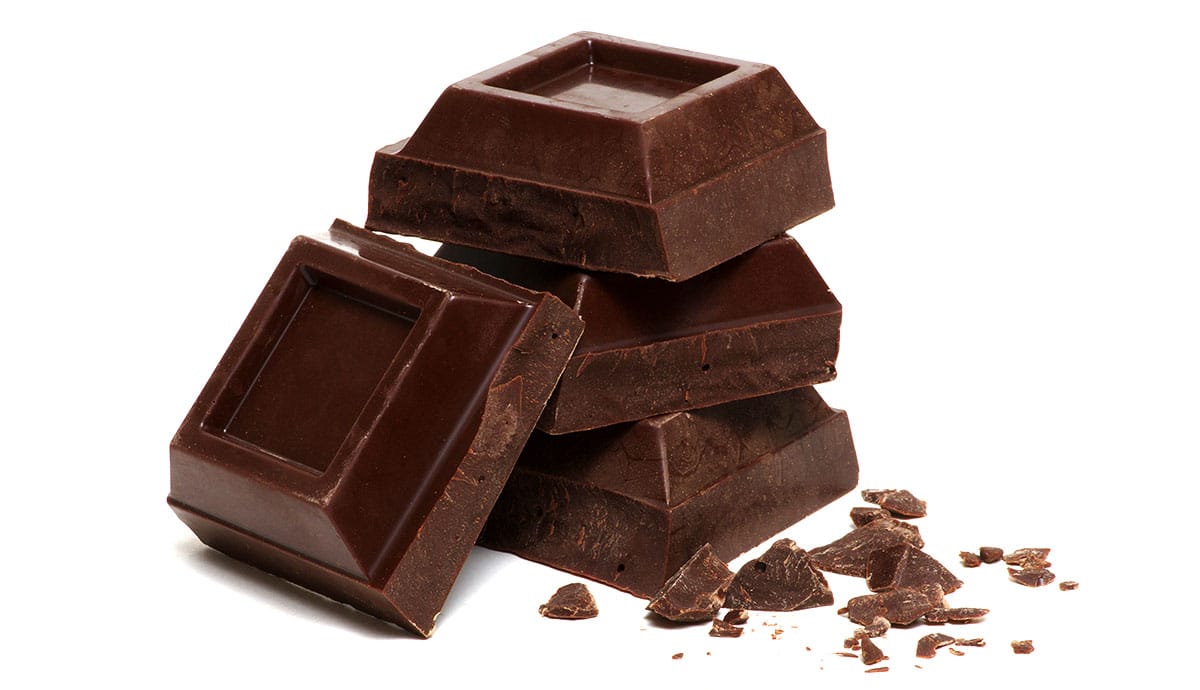
Dark chocolate contains a higher percentage of cocoa solids and less sugar compared to other chocolate varieties like milk chocolate. It’s typically made from cocoa beans, cocoa butter, and sugar.
The cocoa content in dark chocolate can vary, but it generally ranges from 50% to 90% cocoa solids. The higher the cocoa content, the more intense the chocolate flavor becomes. Dark chocolate is known for its rich, bittersweet taste and is a favorite among chocolate connoisseurs.
Nutritional Differences
Cocoa powder is essentially cocoa solids with little to no fat, whereas dark chocolate contains both cocoa solids and cocoa butter. This means that dark chocolate is higher in fat and calories compared to cocoa powder.
However, dark chocolate also provides additional nutrients, such as antioxidants and minerals like magnesium and iron. It’s a source of flavonoids, which are associated with various health benefits when consumed in moderation.
Flavor Differences
The flavor differences between dark chocolate and cocoa powder are quite pronounced. Dark chocolate has a rich, deep, and slightly bitter flavor with notes of cocoa, often accompanied by fruity or nutty undertones, depending on the cocoa bean’s origin.
On the other hand, cocoa powder is unsweetened and has an intense cocoa flavor but lacks the creamy texture and sweetness of dark chocolate. When you substitute dark chocolate for cocoa powder in a recipe, you’ll introduce a more complex and nuanced chocolate flavor, along with the sweetness and creaminess of the chocolate itself.
How to Substitute Dark Chocolate For Cocoa Powder
Substituting dark chocolate for cocoa powder in recipes can be done, but it requires some adjustments. To replace cocoa powder with dark chocolate, follow these general guidelines:
- Measure the dark chocolate: Start with a 1:1 replacement by weight. Adjust this ratio based on your preference for chocolate intensity.
- Melt the dark chocolate: Break the dark chocolate into small pieces and melt it gently using a double boiler or in the microwave, stirring frequently to avoid burning. Be sure to let it cool slightly before using it in your recipe.
- Adjust other ingredients: Since dark chocolate contains sugar and fat, you may need to reduce the amount of sugar and fat (such as butter or oil) in your recipe to maintain the right balance.
- Balance the liquid: Dark chocolate can be slightly thicker than cocoa powder, so you might need to adjust the liquid content in your recipe by adding a bit more liquid if necessary to achieve the desired consistency.
- Taste and adjust: Taste the mixture as you go along and adjust the sweetness and intensity by adding more or less melted dark chocolate as needed.
- Best Uses for Replacing Cocoa with Dark Chocolate
Dark chocolate can be a wonderful replacement for cocoa powder in various recipes, especially those in which you want a richer, more intense chocolate flavor. Some of the best uses include:
Chocolate desserts: Dark chocolate is ideal for making decadent chocolate desserts like brownies, chocolate cake, and chocolate ganache, where the depth of flavor and creaminess can shine. Baking is probably the application in which this substitution is the most difficult to perfect.
Hot chocolate: Instead of using cocoa powder, try melting dark chocolate into hot milk for a luxurious and velvety hot chocolate experience.
Chocolate sauces and drizzles: Dark chocolate can be melted and used to make chocolate sauces for ice cream, fruits, or desserts, providing a glossy, rich finish.
Chocolate truffles: When making chocolate truffles or candies, substituting cocoa powder with dark chocolate can elevate the taste and texture, creating a more indulgent treat.
In summary, dark chocolate is a versatile alternative to cocoa powder in recipes where you want a deeper chocolate flavor and a touch of sweetness. Be mindful of the adjustments needed in terms of sugar, fat, and liquid.
Unsweetened Baking Chocolate
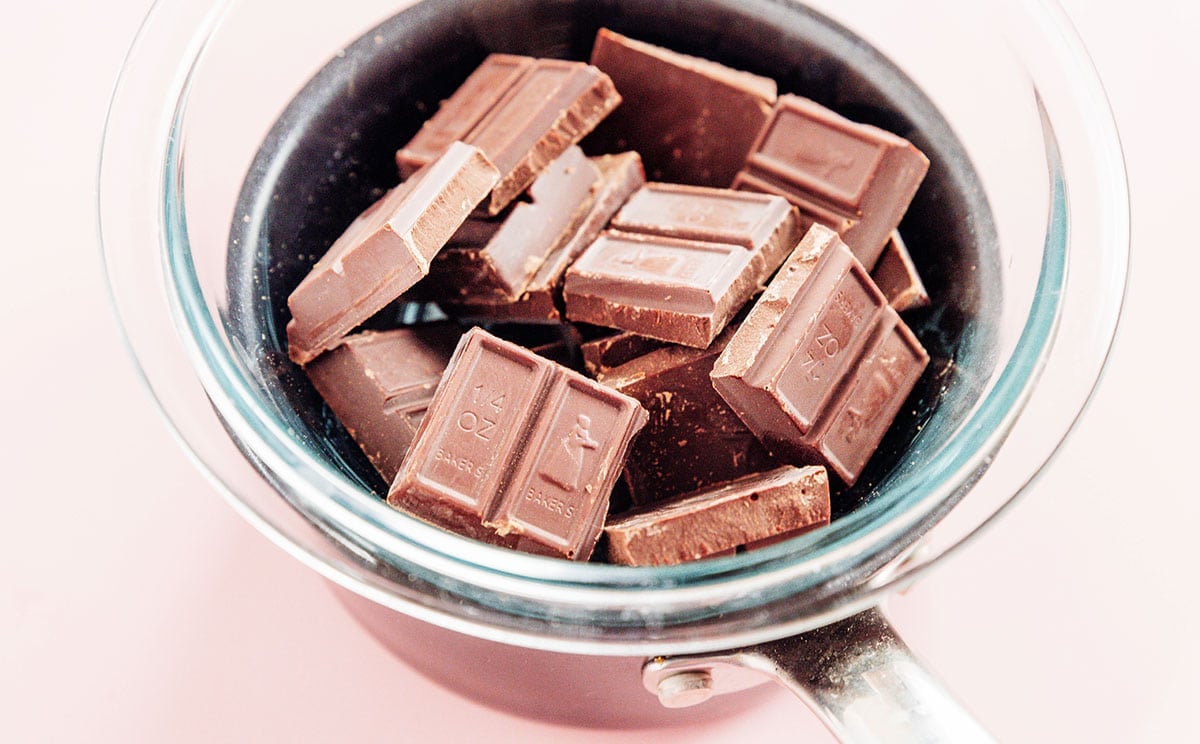
Unsweetened baking chocolate is essentially pure cocoa solids and cocoa butter with no sugar added. Typically, it comes in a solid, bar-like form and needs to be melted before use.
Unsweetened baking chocolate is often used in recipes where the sweetness level needs to be controlled separately, such as brownies, cakes, and chocolate sauces. Its primary purpose is to impart a deep chocolate flavor to dishes without adding sweetness. You can find this in different varieties including semi-sweet, milk, and white chocolate.
Nutritional Differences
Baking chocolate has a higher fat content compared to cocoa powder. Additionally, baking chocolate may have trace amounts of sugar, but it is minimal even compared to cocoa powder, which is often devoid of sugar entirely. Consequently, baking chocolate has a higher calorie count and is more calorie-dense due to its fat content.
Flavor Differences
The most significant difference between cocoa powder and unsweetened baking chocolate is the intensity of flavor. While it is not sweet, baking chocolate has a rich and deep chocolate flavor due to its high cocoa content and fat content. It contributes a smooth, velvety texture to recipes and can result in a more fudgy or dense texture in baked goods. On the other hand, cocoa powder offers a milder, slightly bitter chocolate flavor and is often used in recipes that require a less intense chocolate taste.
How to Substitute Unsweetened Baking Chocolate for Cocoa Powder
Substituting unsweetened baking chocolate for cocoa powder can be done, but it requires some adjustments to the recipe.
- Melt the Baking Chocolate: First, melt the unsweetened baking chocolate. Usually, this involves chopping the chocolate into small pieces and melting it over low heat or in a microwave until it becomes smooth and liquid.
- Adjust the Amount: As a general rule of thumb, you can use 1 ounce (28 grams) of unsweetened baking chocolate to replace 3 tablespoons of cocoa powder. Adjust the quantity according to your specific recipe, but keep in mind that baking chocolate contains more fat, so you may need to reduce the amount of added fats (like butter or oil) in your recipe.
- Consider Sweetness: Since baking chocolate is unsweetened, you may need to add additional sugar or a sweetener to your recipe to achieve the desired sweetness level.
Best Uses for Replacing Cocoa with Unsweetened Baking Chocolate
Substituting cocoa powder with unsweetened baking chocolate works best in recipes where a pronounced chocolate flavor and a creamy texture are desired. Some ideal uses include brownies, chocolate sauces, truffles, and fudge.
It can also work well in recipes where the added fat from the baking chocolate enhances the overall texture, such as certain chocolate cakes and cookies. However, in recipes where the sweetness of cocoa powder plays a critical role, like in hot chocolate or certain chocolate beverages, additional sweetening adjustments would be necessary to balance the flavors.
Hot Chocolate Mix
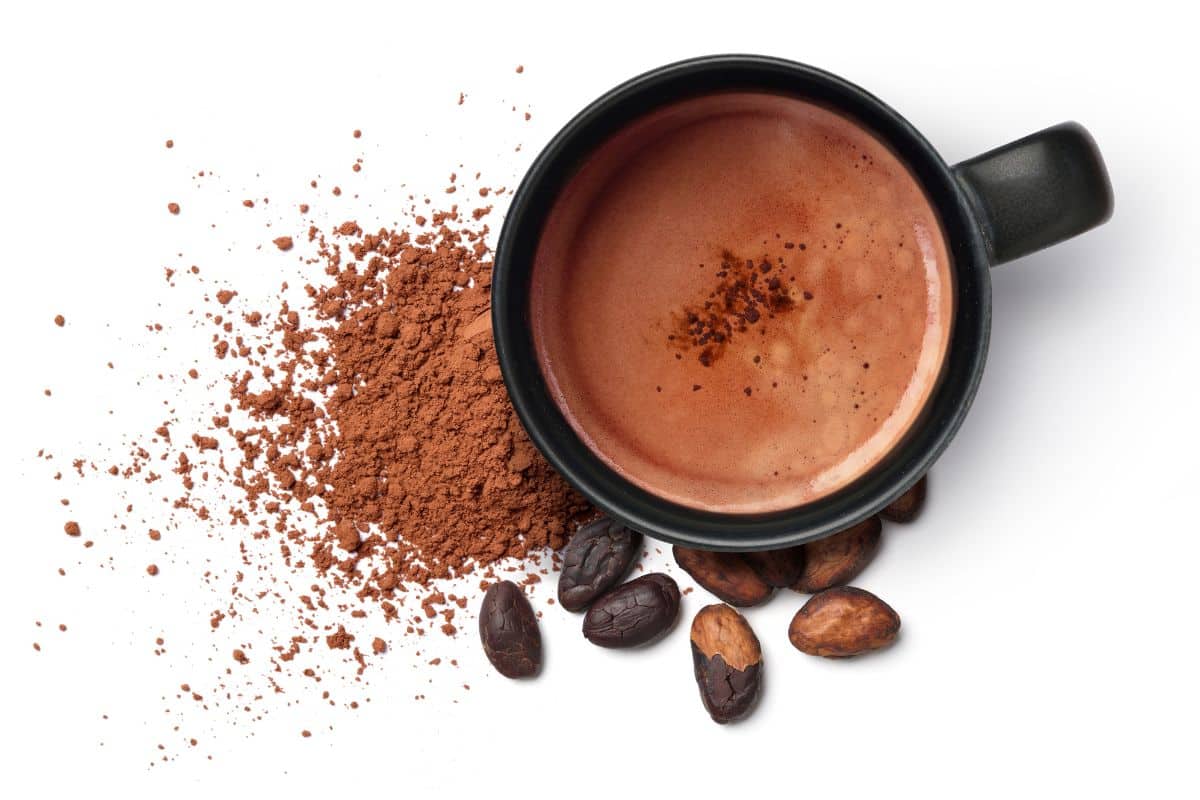
Hot chocolate mix is a powdered beverage typically used to make hot cocoa or hot chocolate. Hot chocolate mix usually contains a combination of cocoa powder, sugar, powdered milk, and sometimes additional flavorings like vanilla or marshmallows. It is not our favorite substitute for cocoa powder. It just seems to perform inconsistently likely due to the differences in type and brand.
Nutritional Differences
Cocoa powder is generally lower in sugar and contains more cocoa solids, making it a purer source of chocolate flavor. On the other hand, hot chocolate mix is designed to be sweeter and creamier, which means it often contains more sugar and added dairy components.
As a result, substituting hot chocolate mix for cocoa powder may introduce more sweetness and potentially more calories into your recipe. If you’re concerned about the nutritional differences, you can adjust the sugar and dairy content in your recipe accordingly.
Flavor Differences
The flavor differences between hot chocolate mix and cocoa powder are significant. Cocoa powder has a deep, intense chocolate flavor with a slight bitterness. In contrast, hot chocolate mix is formulated to be sweeter and creamier, often with a more mild and less intense chocolate flavor.
When you substitute hot chocolate mix for cocoa powder in a recipe, you can expect a sweeter and milder chocolate taste. This can work well in certain desserts or drinks where a pronounced chocolate flavor isn’t the primary goal.
How to Substitute Hot Chocolate Mix for Cocoa Powder
To substitute hot chocolate mix for cocoa powder, you’ll need to make some adjustments to account for the differences in sweetness and dairy content. We recommend starting with a 1:2 ratio, meaning if your recipe calls for 1 tablespoon of cocoa powder substitute with 2 tablespoons of hot chocolate mix. From here make some adjustments:
- Reduce Sugar: Hot chocolate mix contains sugar, so you’ll want to reduce the amount of sugar specified in your recipe. Start by cutting the sugar by about half and adjust based on taste.
- Adjust Dairy: Hot chocolate mix typically includes powdered milk. Depending on your recipe, you may need to reduce other dairy ingredients like milk or cream.
- Flavor Balance: Consider the overall flavor balance of your recipe. You might need to add more cocoa mix to achieve the desired chocolate flavor if your recipe relies heavily on the chocolate taste or use a different substitute.
- Experiment: It may take some trial and error to get the substitution just right. Start with a smaller batch to test the flavor and adjust as needed.
Best Uses for Replacing Cocoa with Hot Chocolate Mix
- Mocha: Use hot chocolate mix instead of cocoa powder when making mocha beverages. Mix it with coffee and milk for a sweet and creamy mocha.
- Chocolate-Based Desserts: Hot chocolate mix can work in recipes for brownies, chocolate cakes, and chocolate-flavored frosting, where a sweeter and less intense chocolate flavor is acceptable. It is a bit harder to get the substitution right in baking than say chocolate drinks or sauces.
- Iced Chocolate Drinks: Use hot chocolate mix to make iced chocolate drinks by dissolving it in cold milk and adding ice.
In summary, hot chocolate mix can be a convenient substitute for cocoa powder in certain recipes, especially those that benefit from a sweeter and creamier chocolate flavor. However, it’s essential to adjust the sugar and dairy components to maintain the overall balance of the original recipe.
Chocolate Protein Powder
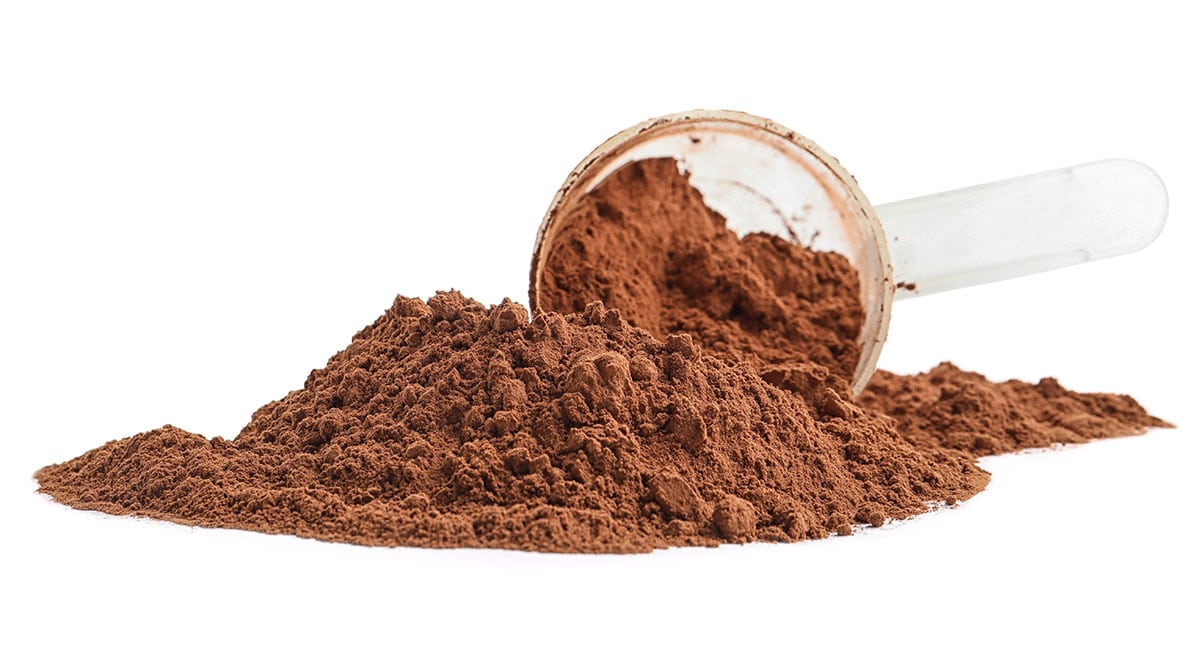
Chocolate protein powder is a powdered supplement designed to provide a convenient source of protein while delivering a rich chocolate flavor. It is commonly used by athletes, fitness enthusiasts, and individuals seeking to increase their protein intake, especially after workouts. Chocolate protein powder is typically made from various protein sources, such as whey, casein, soy, or plant-based proteins, and it is often fortified with vitamins and minerals.
Nutritional Differences
Cocoa powder is primarily a cocoa bean-derived product and is rich in cocoa solids, which provide a deep chocolate flavor but minimal nutritional content. On the other hand, chocolate protein powder contains whey, or some other source of protein, which can vary in quantity depending on the brand and type. It may also contain added sugars, flavorings, and other nutrients.
Chocolate protein powder can be a more nutritionally balanced choice as it not only adds flavor but also contributes to your daily protein intake. Read the label before you buy. There are powders with little to no sugar, and others that are very heavy in sugar. We like powders that contain 20g of protein per 100 calories meaning 80% of calories come from protein. This ensures there isn’t much sugar.
Flavor Differences
The flavor difference between cocoa powder and chocolate protein powder is notable. Cocoa powder offers a pure, intense chocolate flavor with a slightly bitter undertone, making it ideal for baking and making hot cocoa.
Chocolate protein powder, however, has a milder chocolate taste that is often sweetened to make it more palatable. Additionally, protein powder may contain other flavorings, such as vanilla or caramel, which can affect the overall taste. Before substituting, mix up a bit of protein powder and check the taste for yourself.
How to Substitute Chocolate Protein Powder For Cocoa Powder
Substituting chocolate protein powder for cocoa powder in recipes can be a straightforward process. To do this effectively, start with a 1:1substitution and then consider the following steps:
- Adjust for Sweetness: Chocolate protein powder is often sweetened, so you may need to reduce the sugar in your recipe to account for the added sweetness. Taste the mixture as you go to achieve your desired level of sweetness.
- Maintain Consistency: Cocoa powder is dry and powdery, while chocolate protein powder may have a different texture due to added ingredients. To maintain the right consistency in your recipe, you might need to adjust the amounts of other dry or wet ingredients, such as flour or liquid.
Best Uses for Replacing Cocoa with Chocolate Protein Powder
We really only recommend protein powder as a cocoa powder alternative if you are trying to turn a recipe into a post-workout food.
- Smoothies and Shakes: Chocolate protein powder can enhance the flavor and nutritional value of your smoothies and shakes. This is the no-brainer use for protein powder over cocoa powder.
- Protein-Rich Desserts: When making desserts like chocolate protein bars, brownies, or protein balls, replacing cocoa with chocolate protein powder not only imparts a chocolatey flavor but also boosts the protein content, making them a more nutritious treat. Kind of another no-brainer use.
- Hot Cocoa: While cocoa powder is the traditional choice for hot cocoa, you can use chocolate protein powder to create a creamy, protein-packed version of this comforting beverage. Adjust the sweetness to your liking and enjoy the added benefits of protein.
In summary, protein powder is certainly a healthy replacement for cocoa powder, but there are big differences in brands of protein powder making cooking with it a bit of a trial-and-error gambit. Stick to simple things like smoothies, protein bars, and brownies. We don’t recommend trying to make baked goods like cakes with protein powder.
Nutella
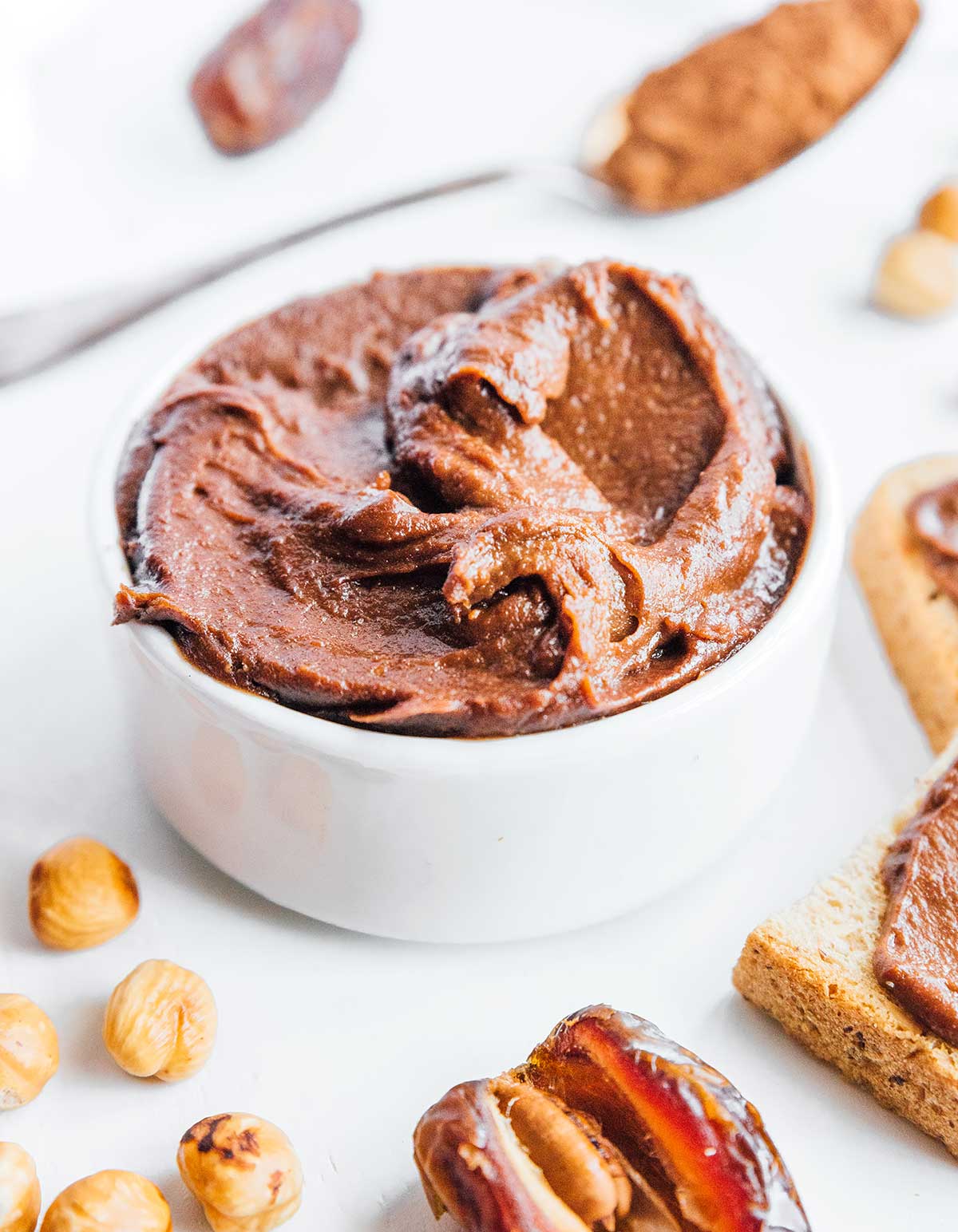
Nutella is a popular sweet spread that originated in Italy and has gained worldwide popularity. It is primarily composed of hazelnuts, cocoa solids, sugar, and palm oil, which are blended into a creamy and rich chocolate hazelnut paste. Nutella is known for its delightful balance of sweet and nutty flavors, making it a versatile ingredient for various culinary creations, such as spreading on toast, filling pastries, or incorporating into desserts. You can buy it at most grocery stores, or better yet make your own homemade nutella.
Nutritional Differences
These two are very different nutritionally. Cocoa powder is essentially cocoa solids with most of the cocoa butter removed, making it low in fat and sugar. In contrast, Nutella is a sweet spread with a higher fat and sugar content due to its combination with hazelnuts and sugar.
Flavor Differences
The flavor differences between Nutella and cocoa powder are quite distinct. Cocoa powder has a deep and intense chocolate flavor with a hint of bitterness, which is especially suitable for recipes where a strong chocolate taste is desired, like in brownies or chocolate cakes.
Nutella, on the other hand, offers a sweeter, creamier, and nuttier flavor profile due to the addition of hazelnuts and sugar. Using Nutella in place of cocoa powder will result in a hazelnut taste, so only make this substitution if you are okay giving up the chocolate taste in your recipe.
How to Substitute Nutella for Cocoa Powder
For every 3 tablespoons of cocoa powder required, you can generally replace it with 2 tablespoons of Nutella. Keep in mind that Nutella contains additional fats and sugars, so you may need to reduce the quantities of other ingredients like sugar or butter to achieve the desired taste and texture.
It’s also crucial to consider the moisture content, as Nutella can add extra moisture to your recipe. You will likely need to reduce other liquid ingredients slightly to compensate for this. Additionally, be aware that the final product will have a sweeter, creamier, and nuttier flavor compared to using cocoa powder.
Best Uses for Replacing Cocoa with Nutella
Substituting Nutella for cocoa powder can work well in a variety of recipes, depending on your flavor preferences. Here are some best uses for this substitution:
- Chocolate Spreads: Nutella is an excellent replacement for cocoa powder when making chocolate spreads or frostings. Its creamy texture and rich flavor enhance the sweetness and nuttiness of the spread, making it perfect for topping pancakes, or waffles, or as a filling for pastries.
- Hot Chocolate: When making hot chocolate, you can mix Nutella directly into warm milk to create a creamy and indulgent cocoa drink with a distinctive hazelnut twist.
- Chocolate-Hazelnut Desserts: Recipes that call for both chocolate and hazelnuts, such as some cookies or brownies, can benefit from the Nutella substitution. It adds a unique flavor dimension while providing moisture and sweetness to the dessert.
- Smoothies and Milkshakes: Nutella can be a delicious addition to smoothies or milkshakes, offering a sweet and nutty undertone to the chocolatey goodness of these beverages.
In conclusion, substituting Nutella for cocoa powder will create a nuttier flavor in your recipe, but be sure to adjust other ingredients through trial and error to achieve the best results. This is not a good substitute in baking. You will likely struggle to get the right consistency in your baking other than perhaps brownies.
Nutritional Content of Cocoa Powder and Substitutes
| Cocoa Powder | Cacao Powder | Dark Choc | Protein Powder | |
| Calories | 80 | 130 | 170 | 110 |
| Protein (g) | 3 | 2 | 2 | 18 |
| Fat (g) | 4.5 | 12 | 12 | 2 |
| Carbs (g) | 19 | 11 | 15 | 3 |
As chocolate products go, cocoa powder is a fairly low-calorie option. Certainly lower than the replacements we list here. We will let you judge these cocoa powder replacements for yourself.
That wraps up our look at cocoa powder substitutes. We hope you found a good alternative to cocoa powder you like, and as always happy cooking!
Trivia Answer
Historians believe the first chocolate was made between 1500 and 1900 BCE. So, humans have enjoyed chocolate for almost 4,000 years!
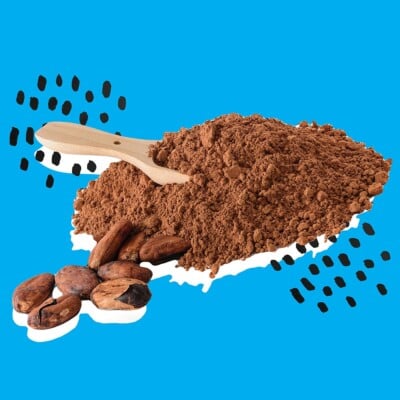
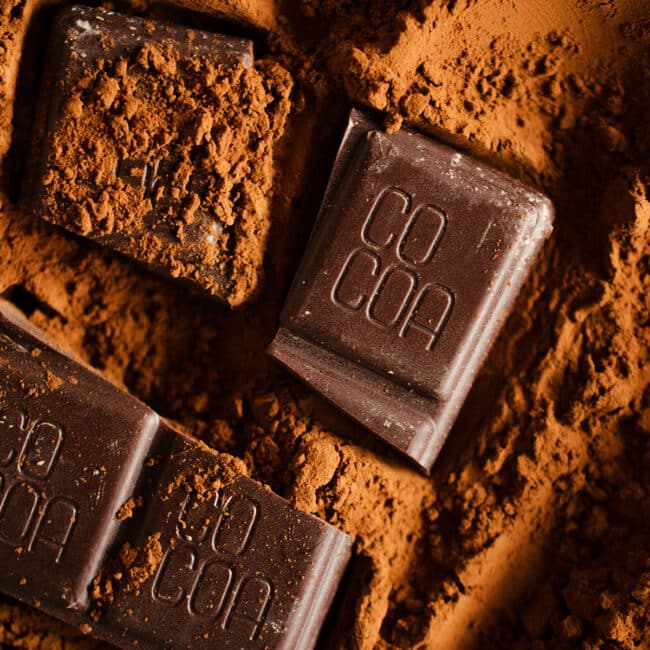


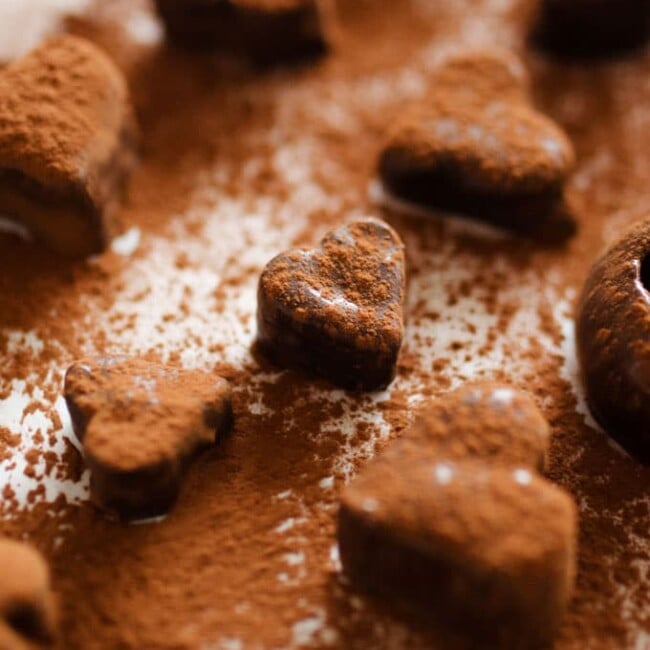
Leave a Comment